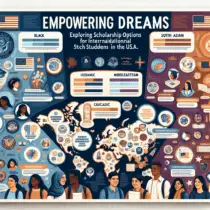Empowering Dreams: Exploring Scholarship Options for International Students in the USA
No dream is too big, and no barrier should stand in the way of pursuing higher education. For international students, studying in the United States is a dream that is often accompanied by financial concerns. However, thanks to various scholarship options, this dream can become a reality. Scholarships not only provide financial assistance but also empower students to realize their full potential and contribute to society. In this article, we will explore the scholarship options available for international students in the USA.
1. Merit-Based Scholarships
Merit-based scholarships are awarded based on academic achievements, extracurricular activities, and personal achievements. These scholarships recognize outstanding students and provide them with financial support to pursue their educational goals. Many universities in the USA offer merit-based scholarships for international students.
For example, Stanford University offers the Knight-Hennessy Scholars Program, which provides full funding for graduate studies to exceptional international students. The program aims to develop future leaders who can tackle global challenges effectively.
2. Need-Based Scholarships
Unlike merit-based scholarships, need-based scholarships focus on providing financial assistance to students who demonstrate a significant need for support. These scholarships consider factors such as family income and assets when determining eligibility.
The United States government offers need-based scholarships through programs like the Federal Pell Grant and the Federal Supplemental Educational Opportunity Grant (FSEOG). These grants are available to both domestic and international students who demonstrate financial need.
3. Ethnicity-Specific Scholarships
In order to promote diversity and inclusivity on campuses, many organizations offer ethnicity-specific scholarships for international students from underrepresented communities.
The Asian & Pacific Islander American Scholarship Fund (APIASF) is one such organization that provides scholarships to Asian and Pacific Islander students. This fund aims to increase access to higher education for these communities and support their academic success.
4. Field-Specific Scholarships
Students who plan to pursue specific fields of study can benefit from field-specific scholarships. These scholarships are often offered by professional organizations, corporations, or foundations that have an interest in supporting the development of professionals in a particular field.
For example, the National Society of Professional Engineers (NSPE) offers scholarships to international students studying engineering. These scholarships not only provide financial assistance but also connect students with a network of professionals in their desired field.
5. Sports Scholarships
If you excel in a particular sport, you may be eligible for sports scholarships. Many universities in the USA offer athletic scholarships to international students who demonstrate exceptional athletic abilities.
The National Collegiate Athletic Association (NCAA) regulates sports scholarships and provides guidelines for student-athletes interested in pursuing collegiate athletics in the USA.
Frequently Asked Questions
1. Can international students apply for all types of scholarships?
International students are eligible to apply for most scholarships; however, some scholarships may have specific eligibility criteria that restrict international applicants. It is important to carefully review the requirements before applying.
2. Are full-tuition scholarships available for international students?
Yes, there are universities and organizations that offer full-tuition scholarships specifically for international students. These scholarships cover both tuition fees and living expenses.
3. Do scholarship recipients need to maintain certain academic standards?
In many cases, scholarship recipients must maintain a certain GPA or academic standing in order to continue receiving the scholarship. It is important to understand the requirements and responsibilities associated with each scholarship.
4. How can international students find scholarships?
International students can find scholarships through various sources such as university websites, scholarship search engines, and community organizations. It is also recommended to reach out to the international student office at universities for guidance on available scholarships.
5. Can scholarship recipients work while studying in the USA?
Each scholarship may have different regulations regarding work restrictions. Some scholarships may allow recipients to work on-campus, while others may restrict employment. It is important to clarify the work restrictions with the scholarship provider.
In conclusion, international students have several scholarship options available to fulfill their dreams of studying in the USA. These scholarships not only provide financial support but also open doors to a world of opportunities and empower students to make a positive impact in their chosen fields. By exploring the various scholarship options, international students can turn their dreams into reality and pave their way towards a brighter future.






